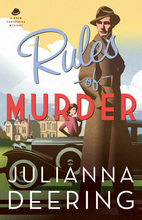"Rules of Murder" - A Drew Farthering Mystery, by Julianna Deering

- In the golden age of detective fiction - the 1920's-1930's - there were certain rules to detective fiction to make it a game for the reader, so that by following the clues the reader competes with the detective to figure out "whodunit" first. Among the most famous authors are the esteemed Sir Arthur Conan Doyle (Sherlock Holmes), Dorothy Sayers (Lord Peter Wimsey), and Agatha Christie (Miss Marple and Poirot).
- Ronald Knox, a British priest and theologian who happened to enjoy good mysteries and the odd hoax, penned these Ten Commandments of a detective story:
- The criminal must be mentioned in the early part of the story, but
must not be anyone whose thoughts the reader has been allowed to know.
- All supernatural or preternatural agencies are ruled out as a matter of course.
- Not more than one secret room or passage is allowable.
- No hitherto undiscovered poisons may be used, nor any appliance which will need a long scientific explanation at the end.
- No Chinaman must figure in the story.
- No accident must ever help the detective, nor must he ever have an unaccountable intuition which proves to be right.
- The detective himself must not commit the crime.
- The detective is bound to declare any clues which he may discover.
- The "sidekick" of the detective, the Watson, must not conceal from
the reader any thoughts which pass through his mind: his intelligence
must be slightly, but very slightly, below that of the average reader.
- Twin brothers, and doubles generally, must not appear unless we have been duly prepared for them.
Our author - Julianna Deering - admits to having broken (or at least bent) as many of these rules as possible with her story, Rules of Murder.
A suitable setting for the cozy mystery genre, the novel takes place in England in the 1930's. Ellison Andrew Farthering, alias Drew, returns home to his estate to find his mother and stepfather hosting a house party and business meeting, with guests from America arriving the next morning. While Drew squires his stepfather's American niece, Madeline Parker, about the grounds later on, they stumble upon the dead body of one of the house guests. Embezzlement, blackmail, and red herrings abound as Drew, his best friend Nick, and Madeline investigate the murder, with the help of the local police.
I should like to point out that while I never skip ahead to read the end of the book, occasionally I do skip ahead to the author's note, if they have one, as it usually includes a bit of historical or otherwise interesting information relating to the book, and usually it doesn't include key plot points to ruin the story. Thus I found out the importance of Father Knox's Decalogue of detective fiction before reaching the end, and thus was enlightened as to why it featured so prominently in the text. Naturally other authors have deliberately broken all the rules before, but Deering manages it in a highly amusing and almost satirical way, given Nick's running commentary about it.
Being a mystery and not a suspense, this novel is not written to thrill or to scare, but to lay out sufficient clues to solve the murder yet still hopefully surprise the reader. I thought myself so clever early on, having caught on to a glossed-over clue, but while it was highly important, I still interpreted it wrong and didn't beat Drew to the murderer. Good job, Julianna Deering!
Deering's book reminded me of Dorothy Sayers' Lord Peter Wimsey novels: not only is the main character a gentleman larking about, but Rules of Murder begins with the levity so common in many of Sayers' earlier works, and yet like her later novels, the plot sobers as it becomes less a game and more a burden for the characters. Given the upbeat nature of the majority of the book, I was surprised by how grave it becomes; it lends a greater maturity to the book than I was expecting. Also, though the murder is solved, the end is not wholly concluded, which befits the start of a series. I am curious to see what happens next.
Is this a perfect novel? No, the romance is a bit fast and the
spiritual depth a little shallow (though it does leave room for growth
in subsequent novels). But is it a good novel? Yes. I cannot agree
with the overly harsh editorial review by Publishers Weekly;
this book does not deserve such an attack. It is a solid start to a series, written in much the style of the great mystery writers. 4 out of 5 stars
Who is your favorite detective or mystery writer?
Post Script: for the record, this novel not remotely related to Downton Abbey - it may be the same country, but it is a different decade and a completely different genre. I like them both, but I would not classify them together.
Drew Farthering Mysteries
1. Rules of Murder
2. Death by the Book
3. Murder at the Mikado
4. Dressed for Death - 5. Murder on the Moor
- 6. Death at Thorburn Hall

No comments:
Post a Comment